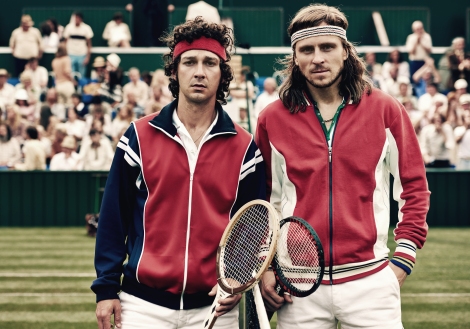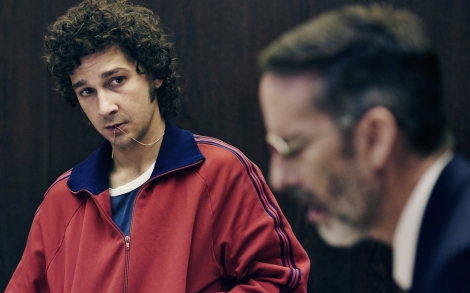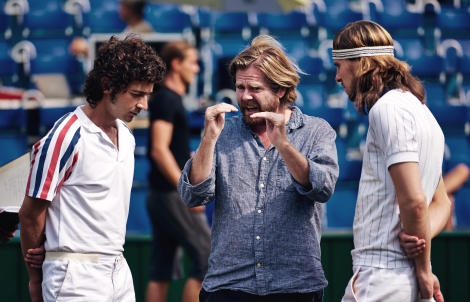Directed by: Janus Metz
Written by: Ronnie Sandahl
Starring: Sverrir Gudnason, Shia LaBeouf, Stellan Skarsgård, Tuva Novotny
Produced by: Jon Nohrstedt, Fredrik Wikström Nicastro
Music by: Vladislav Delay, Jon Ekstrand, Carl-Johan Sevedag, Jonas Struck
Cinematography by: Niels Thastum
Edited by: Per K. Kirkegaard, Per Sandholt

Shia LaBeouf (left) as John McEnroe, and Sverrir Gudnason as Björn Borg. Courtesy of NEON
“Beauty is not the goal of competitive sports, but high-level sports are a prime venue for the expression of human beauty…What it seems to have to do with, really, is human beings’ reconciliation with the fact of having a body.” – David Foster Wallace, The New York Times.
*****
Why do we underestimate Shia LaBeouf, I wonder?
My instinct tells me that, because he is a renegade and a lush, and because his aggression can sometimes read like violence (or manifest into actual violence), audiences cannot tell what is performance and what is psychosis. Like Crispin Glover or the late Dennis Hopper – appreciated in their time, but never quite justly – LaBeouf infuses even his most docile characters with abundant, but volatile, charisma. How can you trust someone like that?
Janus Metz, the Danish director of Borg vs. McEnroe, recognizes this problem, and seems to have found the key to harnessing it. LaBeouf is perfectly cast as John McEnroe, the curly-headed tennis star who competed at the 1980 Wimbledon against the Number One player in the world at that time, Björn Borg (Sverrir Gudnason). Where McEnroe’s genius was at odds with his volcanic rage, Borg was the opposite picture of calm – a barely-controlled placidity which the screenplay, by Ronnie Sandahl, argues was a lie.
Gudnason plays Borg as a cold echo of McEnroe’s, equally tortured in his private life but reserved only on the court (in fact, the film’s original title was Borg McEnroe, as if they were two parts of the same name.)
We first see the champ dangling from a balcony in Monaco, no doubt wondering what could happen if he dropped a tennis ball from that height. Soon after, he is abusing his wife, the tennis star Mariana Simionescu (Tuva Novotny, of Annihilation, unrecognizable here in blonde wig and brown contact lenses) and his beleaguered, long-time coach (Stellan Skarsgård, the only choice for anyone looking to cast a Swedish authority figure.)

Tuva Novotny (right) as Mariana Simionescu with Sverrir Gudnason. Courtesy of NEON
Borg’s main source of discomfort, Sandahl suggests, was his impending match with McEnroe, whose career was skyrocketing and who represented the death of the Swede’s career at the top. By 1980, Borg had won the championship 4 times, making him among the world’s most famous athletes; but he lacked McEnroe’s wounded humanity, for which McEnroe became legendary while still so young. Sometimes life comes at you even faster than a serve.
Why virtually the entire third act of the film is devoted to the stand-off of the title – though both men would compete against one another at Wimbledon the following year – is lost on me. Knowing what we know about him, I would have been happy to see McEnroe get some kind of therapy instead, for example.
But Metz and Sandahl instead glide so swiftly through flashbacks – McEnroe’s father (Ian Blackman) manhandling his career; Borg smacking tennis balls against his childhood garage – that we never get a sense of what truly drove these athletes to become so devoted to excellence at cost to everything else.
That is left to the actors, who are unanimously electrifying despite the script’s shortcomings.
LaBeouf turned toxic desirability into the molten core of Andrea Arnold’s American Honey, and he does the same here. Even though he can’t quite match the real man’s physicality, he succeeds in making McEnroe’s outbursts look like practical exercise habits, necessary ventilation for the internal incinerator we all know to be working around the clock.
Buried below the angry crust is the sarcastic intellect that would later bring McEnroe into demand as a self-satirist on 30 Rock and Saturday Night Live. Humor may be McEnroe’s least-explored asset in the many interviews or documentaries about him in the past, yet LaBeouf brings it admirably, quietly, to life.

Courtey of NEON

Courtesy of NEON
Gudnason’s, however, is the star-making performance. As Borg, he is a quiet terror: obsessive-compulsive, superstitious, brutal.
Ducking from paparazzi in Monaco, he first lies to the barista about his occupation, then realizes he forgot his wallet back home; in Wimbledon, he plays nervously, then accuses his coach of sabotaging him. Gone is the sexy, statesmanlike star of 1980s lore, replaced here by a self-doubting boy threatened by a more assured counterpart.
Gudnason gives shape to the role through his eyes, and what beautiful eyes: the cold, sad blue of Scandinavian lore. It was no surprise at all to learn that he has been cast as Mikael Blomkvist in the Hollywood adaptation of The Girl in the Spider’s Web, from the Millennium series.
If targeted properly, he might be the year’s first shoe-in for an Independent Spirit Award nomination.
However, while Metz probably has a stronger understanding of Nordic masculinities than my own, the argument that Borg was merely masking some inner angst – unfiltered (or perhaps unfilterable) by the more vulnerable McEnroe – seems to me an oversimplified explanation for his hostility.

Janus Metz (center) with Shia LaBeouf and Sverrir Gudnason (right). Courtesy of NEON
Consider his torturous relationship with Skarsgård’s Lennart Bergelin, Borg’s impassioned mentor. Bergelin handles Borg’s private outbursts with repose, but that hardly makes them acceptable.
Even more painful – and I cannot imagine a worse time to see such male-female manipulation onscreen – is the emotional torment that Borg imposes on Mariana, his first wife. Despite Simionescu’s quite remarkable career, Novotny’s is a somewhat thankless role, forced to shoulder her husband’s frustrations and doubt without ever performing as an athlete (onscreen) herself. She speaks so inoften, in fact, that I was left wondering how much of Novotny’s performance was cut from the film.
Aside from this unfortunate disrespect – mostly Borg’s, if Sandahl’s script is accurate – editors Per K. Kirkegaard (one wonders about his ancestry) and Per Sandholt are in otherwise excellent form, as is the gifted cinematographer, Niels Thastum. Between the three of them, the titular match becomes a rousing battle of tracking shots, jump cuts, and swivels.
In fact, as tennis films go, Borg vs. McEnroe is a minor masterclass in visual matching (the team behind last year’s here-and-gone King vs. Riggs picture, Battle of the Sexes, certainly could have used the lesson – once thought to be an awards frontrunner, their movie received no Academy Award recognition in 2018.)
Then again, if your only real competitor is the 2005 romcom Wimbledon, what exactly are the stakes?
NEON presents Borg Vs. McEnroe, an Official Selection of the 2017 Toronto International Film Festival, in theaters April 13.
Editor’s Note: Journalism is hard and criticism often equally so, but we continue unabated our half-decade enterprise of highlighting undervocalized and underexposed voices in cinema, music, comedy, and culture. Help us continue to provide subscribers with exclusive conversations with up-and-coming filmmakers, Oscar-nominees, and legendary comics by making a tax-deductible donation to CineMalin today.
